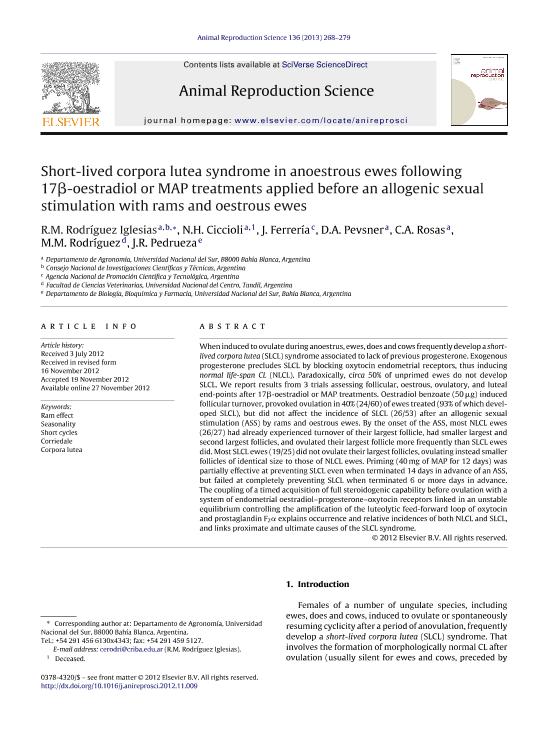Artículo
Short-lived corpora lutea syndrome in anoestrous ewes following 17β-oestradiol or MAP treatments applied before an allogenic sexual stimulation with rams and oestrous ewes
Rodríguez Iglesias, Ricardo Manuel ; Ciccioli, N. H.; Ferrería, J.; Pevsner, Damián Andrés
; Ciccioli, N. H.; Ferrería, J.; Pevsner, Damián Andrés ; de Abreu Rosas, Claudia; Rodriguez, M. M.; Pedrueza, Jorge Raúl
; de Abreu Rosas, Claudia; Rodriguez, M. M.; Pedrueza, Jorge Raúl
 ; Ciccioli, N. H.; Ferrería, J.; Pevsner, Damián Andrés
; Ciccioli, N. H.; Ferrería, J.; Pevsner, Damián Andrés ; de Abreu Rosas, Claudia; Rodriguez, M. M.; Pedrueza, Jorge Raúl
; de Abreu Rosas, Claudia; Rodriguez, M. M.; Pedrueza, Jorge Raúl
Fecha de publicación:
01/2013
Editorial:
Elsevier Science
Revista:
Animal Reproduction Science
ISSN:
0378-4320
Idioma:
Inglés
Tipo de recurso:
Artículo publicado
Clasificación temática:
Resumen
When induced to ovulate during anoestrus, ewes, does and cows frequently develop a short-lived corpora lutea (SLCL) syndrome associated to lack of previous progesterone. Exogenous progesterone precludes SLCL by blocking oxytocin endometrial receptors, thus inducing normal life-span CL (NLCL). Paradoxically, circa 50% of unprimed ewes do not develop SLCL. We report results from 3 trials assessing follicular, oestrous, ovulatory, and luteal end-points after 17β-oestradiol or MAP treatments. Oestradiol benzoate (50 μg) induced follicular turnover, provoked ovulation in 40% (24/60) of ewes treated (93% of which developed SLCL), but did not affect the incidence of SLCL (26/53) after an allogenic sexual stimulation (ASS) by rams and oestrous ewes. By the onset of the ASS, most NLCL ewes (26/27) had already experienced turnover of their largest follicle, had smaller largest and second largest follicles, and ovulated their largest follicle more frequently than SLCL ewes did. Most SLCL ewes (19/25) did not ovulate their largest follicles, ovulating instead smaller follicles of identical size to those of NLCL ewes. Priming (40 mg of MAP for 12 days) was partially effective at preventing SLCL even when terminated 14 days in advance of an ASS, but failed at completely preventing SLCL when terminated 6 or more days in advance. The coupling of a timed acquisition of full steroidogenic capability before ovulation with a system of endometrial oestradiol–progesterone–oxytocin receptors linked in an unstable equilibrium controlling the amplification of the luteolytic feed-forward loop of oxytocin and prostaglandin F2α explains occurrence and relative incidences of both NLCL and SLCL, and links proximate and ultimate causes of the SLCL syndrome.
Palabras clave:
Ram Effect
,
Seasonality
,
Short Cycles
,
Corriedale
,
Corpora Lutea
Archivos asociados
Licencia
Identificadores
Colecciones
Articulos(CCT - BAHIA BLANCA)
Articulos de CTRO.CIENTIFICO TECNOL.CONICET - BAHIA BLANCA
Articulos de CTRO.CIENTIFICO TECNOL.CONICET - BAHIA BLANCA
Citación
Rodríguez Iglesias, Ricardo Manuel; Ciccioli, N. H.; Ferrería, J.; Pevsner, Damián Andrés; de Abreu Rosas, Claudia; et al.; Short-lived corpora lutea syndrome in anoestrous ewes following 17β-oestradiol or MAP treatments applied before an allogenic sexual stimulation with rams and oestrous ewes; Elsevier Science; Animal Reproduction Science; 136; 4; 1-2013; 268-279
Compartir
Altmétricas



